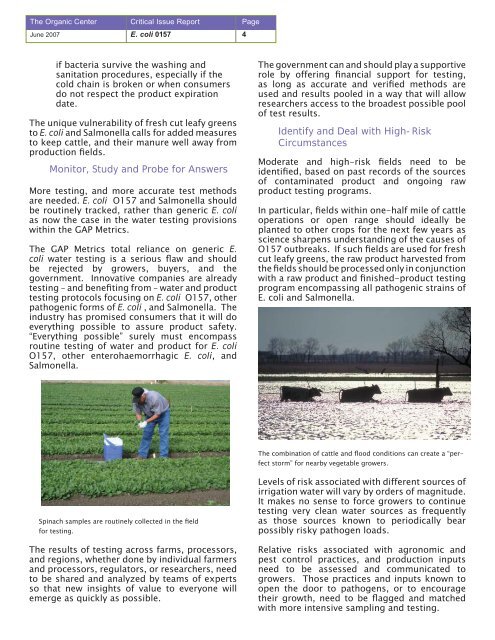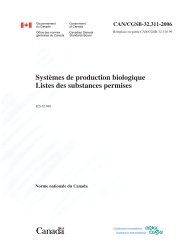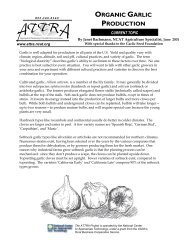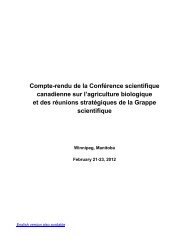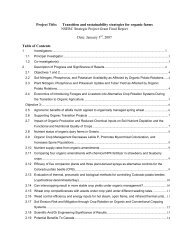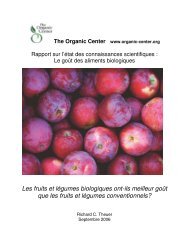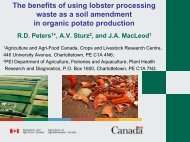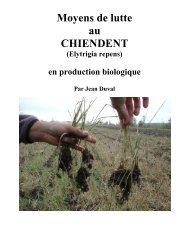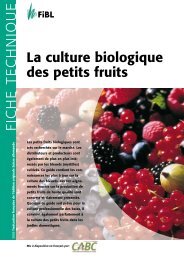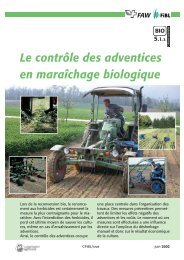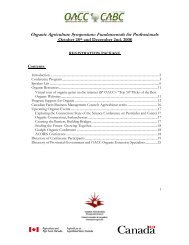Preventing E. Coli 0157 Outbreaks in Leafy Greens
Preventing E. Coli 0157 Outbreaks in Leafy Greens
Preventing E. Coli 0157 Outbreaks in Leafy Greens
Create successful ePaper yourself
Turn your PDF publications into a flip-book with our unique Google optimized e-Paper software.
The Organic Center Critical Issue Report Page<br />
June 20077 E. coli <strong>0157</strong> 4<br />
if bacteria survive the wash<strong>in</strong>g and<br />
sanitation procedures, especially if the<br />
cold cha<strong>in</strong> is broken or when consumers<br />
do not respect the product expiration<br />
date.<br />
The unique vulnerability of fresh cut leafy greens<br />
to E. coli and Salmonella calls for added measures<br />
to keep cattle, and their manure well away from<br />
production fields.<br />
Monitor, Study and Probe for Answers<br />
More test<strong>in</strong>g, and more accurate test methods<br />
are needed. E. coli O157 and Salmonella should<br />
be rout<strong>in</strong>ely tracked, rather than generic E. coli<br />
as now the case <strong>in</strong> the water test<strong>in</strong>g provisions<br />
with<strong>in</strong> the GAP Metrics.<br />
The GAP Metrics total reliance on generic E.<br />
coli water test<strong>in</strong>g is a serious flaw and should<br />
be rejected by growers, buyers, and the<br />
government. Innovative companies are already<br />
test<strong>in</strong>g – and benefit<strong>in</strong>g from – water and product<br />
test<strong>in</strong>g protocols focus<strong>in</strong>g on E. coli O157, other<br />
pathogenic forms of E. coli , and Salmonella. The<br />
<strong>in</strong>dustry has promised consumers that it will do<br />
everyth<strong>in</strong>g possible to assure product safety.<br />
“Everyth<strong>in</strong>g possible” surely must encompass<br />
rout<strong>in</strong>e test<strong>in</strong>g of water and product for E. coli<br />
O157, other enterohaemorrhagic E. coli, and<br />
Salmonella.<br />
The government can and should play a supportive<br />
role by offer<strong>in</strong>g f<strong>in</strong>ancial support for test<strong>in</strong>g,<br />
as long as accurate and verified methods are<br />
used and results pooled <strong>in</strong> a way that will allow<br />
researchers access to the broadest possible pool<br />
of test results.<br />
Identify and Deal with High-Risk<br />
Circumstances<br />
Moderate and high-risk fields need to be<br />
identified, based on past records of the sources<br />
of contam<strong>in</strong>ated product and ongo<strong>in</strong>g raw<br />
product test<strong>in</strong>g programs.<br />
In particular, fields with<strong>in</strong> one-half mile of cattle<br />
operations or open range should ideally be<br />
planted to other crops for the next few years as<br />
science sharpens understand<strong>in</strong>g of the causes of<br />
O157 outbreaks. If such fields are used for fresh<br />
cut leafy greens, the raw product harvested from<br />
the fields should be processed only <strong>in</strong> conjunction<br />
with a raw product and f<strong>in</strong>ished-product test<strong>in</strong>g<br />
program encompass<strong>in</strong>g all pathogenic stra<strong>in</strong>s of<br />
E. coli and Salmonella.<br />
The comb<strong>in</strong>ation of cattle and flood conditions can create a “perfect<br />
storm” for nearby vegetable growers.<br />
Sp<strong>in</strong>ach samples are rout<strong>in</strong>ely collected <strong>in</strong> the field<br />
for test<strong>in</strong>g.<br />
The results of test<strong>in</strong>g across farms, processors,<br />
and regions, whether done by <strong>in</strong>dividual farmers<br />
and processors, regulators, or researchers, need<br />
to be shared and analyzed by teams of experts<br />
so that new <strong>in</strong>sights of value to everyone will<br />
emerge as quickly as possible.<br />
Levels of risk associated with different sources of<br />
irrigation water will vary by orders of magnitude.<br />
It makes no sense to force growers to cont<strong>in</strong>ue<br />
test<strong>in</strong>g very clean water sources as frequently<br />
as those sources known to periodically bear<br />
possibly risky pathogen loads.<br />
Relative risks associated with agronomic and<br />
pest control practices, and production <strong>in</strong>puts<br />
need to be assessed and communicated to<br />
growers. Those practices and <strong>in</strong>puts known to<br />
open the door to pathogens, or to encourage<br />
their growth, need to be flagged and matched<br />
with more <strong>in</strong>tensive sampl<strong>in</strong>g and test<strong>in</strong>g.


